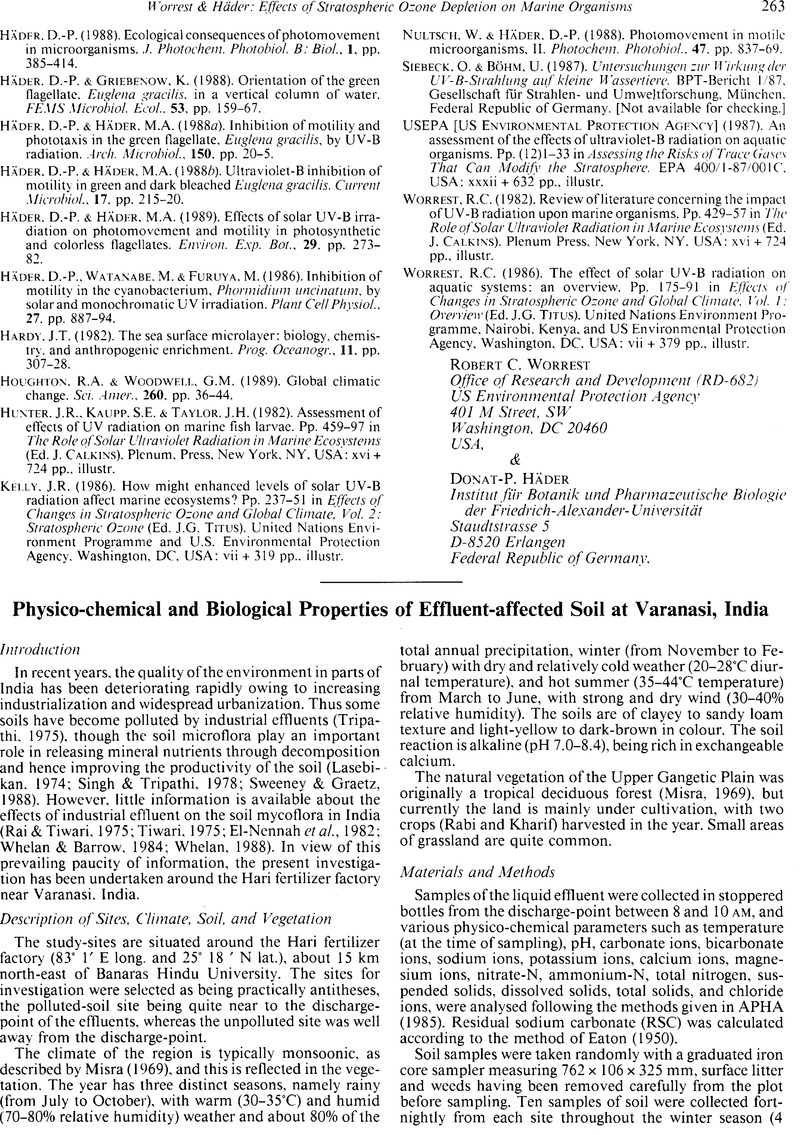No CrossRef data available.
Article contents
Physico-chemical and Biological Properties of Effluent-affected Soil at Varanasi, India
Published online by Cambridge University Press: 24 August 2009
Abstract
An abstract is not available for this content so a preview has been provided. Please use the Get access link above for information on how to access this content.

- Type
- Short Communications & Reports
- Information
- Copyright
- Copyright © Foundation for Environmental Conservation 1989
References
APHA (1985). Standard Methods for the Examination of Water and Wastewater. American Public Health Association, American Water Works Association, and Water Pollution Control Federation, 16th Edition, Inc., New York, NY, USA: [not available for checking].Google Scholar
Barnett, H.L. & Hunter, B.B. (1972). Illustrated Genera of Imperfect Fungi. Burgers Publishing Company, Minneapolis, Minnesota, USA: [not available for checking].Google Scholar
Dwivedi, R.S. (1970). Fungal studies of different habitats with reference to antibiosis and soil fungistasis. Ph.D. thesis. Banaras Hindu University, Varanasi, India: [not available for checking].Google Scholar
El-Nennah, M.P., El-Kabila, A., Shehala, & El-Gamal, I. (1982). Effect of irrigation of loamy-sand soil by sewage effluent on its content of some nutrients and heavy metals. Plant Soil, 65, pp. 289–92.CrossRefGoogle Scholar
Eaton, , (1950). Significance of carbonates in irrigation water. Soil Science, 69, pp. 123–33.Google Scholar
Gilman, J.C. (1957). A Manual of Soil Fungi. Oxford and IBH Publishing Company, Calcutta-Bombay-New Delhi, India: [not available for checking.]CrossRefGoogle Scholar
Gupta, R.C., Tandon, R.N., Arora, D.K., Shukla, A.N. & Singh, D.B. (1979). Dynamics of microfungi in fallowland soils with emphasis on volatile fungistatics. Rev. Ecol. Biol. Sol., 16, pp. 491–7.Google Scholar
Hesse, P.R. (1970). A Text Book of Soil Chemical Analysis. William Clowes, London, Beckles & Colchester, England, UK: 520 pp.Google Scholar
Lasebikan, B.A. (1974). Preliminary communication of microar-thropods from a tropical forest in Nigeria. Pedobiologia, 14, pp. 402–11.CrossRefGoogle Scholar
Martin, J.P. (1950). Use of arid, rose bengal and streptomycin in the plate method for estimating soil fungi. Soil Science, 69, pp. 215–32.Google Scholar
Misra, R. (1968). Ecology Work Book. Oxford & IBH Publishing Company, Bombay, India: 244 pp., illustr.Google Scholar
Misra, R. (1969). The status of plant communities in the upper Gangetic Plain (Presidential address). J. Indian Bot. Soc., 38., pp. 1–7.Google Scholar
Rai, B. & Tiwari, V.K. (1975). Effect of a toxic chemical on soil mycoflora. Acta Bot. Indica, 3, pp. 19–22.Google Scholar
Rai, J.N., Agrawal, S.C. & Tiwari, J.P. (1971). Fungal microflora of Usar soils of India. J. Indian Bot. Soc., 50, pp. 63–74.Google Scholar
Saksena, S.B. (1955). Ecological factors governing the distribution of soil microfungi in some forest soils of Saugar. J. Indian Bot. Soc., 34, pp. 262–98.Google Scholar
Singh, U.R. & Tripathi, B.D. (1978). Effects of industrial effluents on the population density of soil microarthropods. Environmental Conservation, 5(3), pp. 229–31, fig.CrossRefGoogle Scholar
Sweeney, D.W. & Graetz, D.A. (1988). Chemical and decomposition characteristics of anaerobic digester effluents applied to soil. J. Environ. Qual., 17, pp. 309–13.CrossRefGoogle Scholar
Tiwari, U.K. (1975). Effect of Soil Amendments on Qualitative and Quantitative Nature of Mycoflora. Ph.D. thesis, Banaras Hindu University, Varanasi, India: [not available for checking].Google Scholar
Tripathi, B.D. (1975). Ecological Investigation of Certain Plants in Relation to Pollution. Ph.D. thesis, Banaras Hindu University, Varanasi, India: 151 pp. (typescr.). illustr.Google Scholar
Tripathi, B.D. (1978). Soil pollution studies around a factory at Varanasi. International J. Ecol. Environ. Sci., 4, pp. 15–8.Google Scholar
Warcup, J.H. (1955). On the origin of colonies of Fungi developing on soil dilution plates. Trans. Br. Mycol. Soc., 38, pp. 298–301.CrossRefGoogle Scholar
Whelan, B.R. (1988). Disposal of septic tank effluent in calcareous sands. J. Environ. Qual., 17, pp. 272–7.Google Scholar
Whelan, B.R. & Barrow, N.J. (1984). The movement of septic tank effluent through sandy soil near Perth: Movement of nitrogen. Aust. J. Soil Res., 22, pp. 283–92.CrossRefGoogle Scholar


